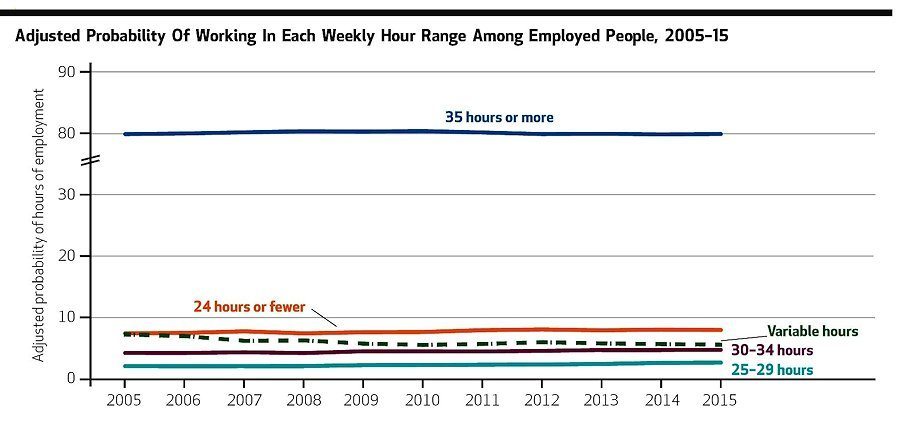Shortly after the passage the Affordable Care Act, many economists predicted that the law would cause employers to slash workweeks to less than 30 hours, to avoid having to provide health insurance to full-time employees.
But that has not happened, according to a comprehensive study reported in the journal Health Affairs. Employees working just above and just under 30 hours per week both experienced virtually no change in their workweeks during the years the ACA has been in effect.
The study looked at Census Bureau data on those working 29 hours per week or less, those working 30 to 34 hours per week, and those working 35 hours per week or more. For all three groups, the probability of working those hours was essentially unchanged from 2005 through 2015, bracketing the 2010 passage of the ACA.
Critics of the health law said it would negatively affect workweeks for several reasons. They said employers would reduce work hours for many of their employees to less than 30 to avoid the requirement to offer health insurance coverage.
They also noted that the ACA made insurance available to those with pre-existing conditions and at affordable costs through Medicaid or subsidized rates on Marketplace exchanges. People who had continued working only to qualify for employer-sponsored group insurance would now be able to drop out of the labor force, they said, further reducing hours worked.
Neither of these predicted changes has had a significant impact, according to the study’s authors, Asako S. Moriya, Thomas M. Selden and Kosali I. Simon. Moriya and Selden are with the Agency for Health Research and Quality, part of the Department of Health and Human Services. Simon is a professor at Indiana University and a researcher with the National Bureau of Economic Research.
They analyzed data from the Current Population Survey conducted annually by the Census Bureau, along with information about state-level variations due to local economic fluctuations.
They then looked at the likelihood of employees working in several hourly ranges: 35 hours and above, 30 to 34 hours, 25 to 29 hours per week, and 24 hours or less.
The probability of working in each of these hourly ranges, they found, remained essentially unchanged over the decade, including in the last couple of years.

Chart courtesy of Health Affairs
“We did not see an increase in 2015 in the probability of working either 25-29 hours or fewer than 25 hours per week,” the study authors wrote.
“We also did not observe a large reduction in 2015 (or in 2014, for that matter) in the frequency of working 30-34 hours, as one might expect if employers affected by the mandate reduced hours for workers just above the 30-hour threshold,” they noted.
From 2013 to 2014 there was a slight increase – less than a fifth of one percentage point – in the prevalence of those working 25 to 29 hours per week, but that “reflected a trend that began before passage of the ACA,” according to the authors.
The study looked at whether significant numbers of employees voluntarily reduced the hours they worked, either because they no longer needed employer-sponsored coverage or because they wanted to reduce their income to qualify for Medicaid or subsidized Marketplace coverage.
“The lack of a meaningful increase in part-time work in 2014 is not consistent with either of these theories,” the authors wrote.
The study also focused on sub-groups of employees. Those with less than a high school diploma presumably would be likely to be in low-skill, low-paid jobs are more susceptible to changes in hours worked. Older workers, age 60-64, are likely to have above-average health care costs, be expensive to cover, and be more likely than younger workers to reduce hours and enroll in Medicaid or subsidized Marketplace plans.
The probability of workers without high school diplomas working 25-29 hours rose from 2.44% in 2013 to 3% in 2015, but “part of this increase may have reflected an ongoing trend that pre-dated passage of the ACA, in which hours of work among workers with low educational attainment were declining for other reasons,” the researchers wrote.
Among older employees, the probability of working 25-29 hours rose from 2.09% in 2013 to 2.59% in 2015. But “there was little increase in involuntary part-time employment” for these older workers, the authors said.
In addition, the voluntary reductions occurred among workers at firms of all sizes. That suggests that the slight increase in part-time work among older workers resulted from their decision to work fewer hours, rather than changes made by employers, the researchers stated.





